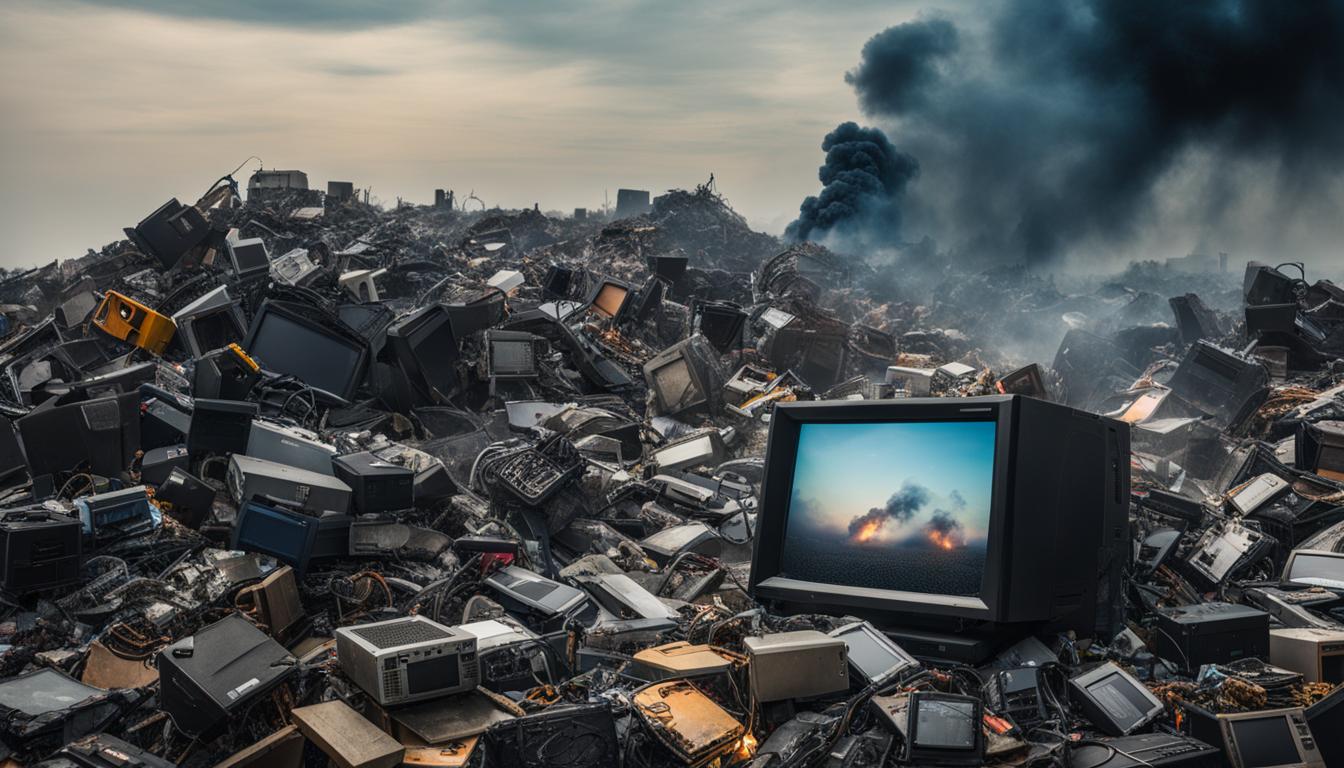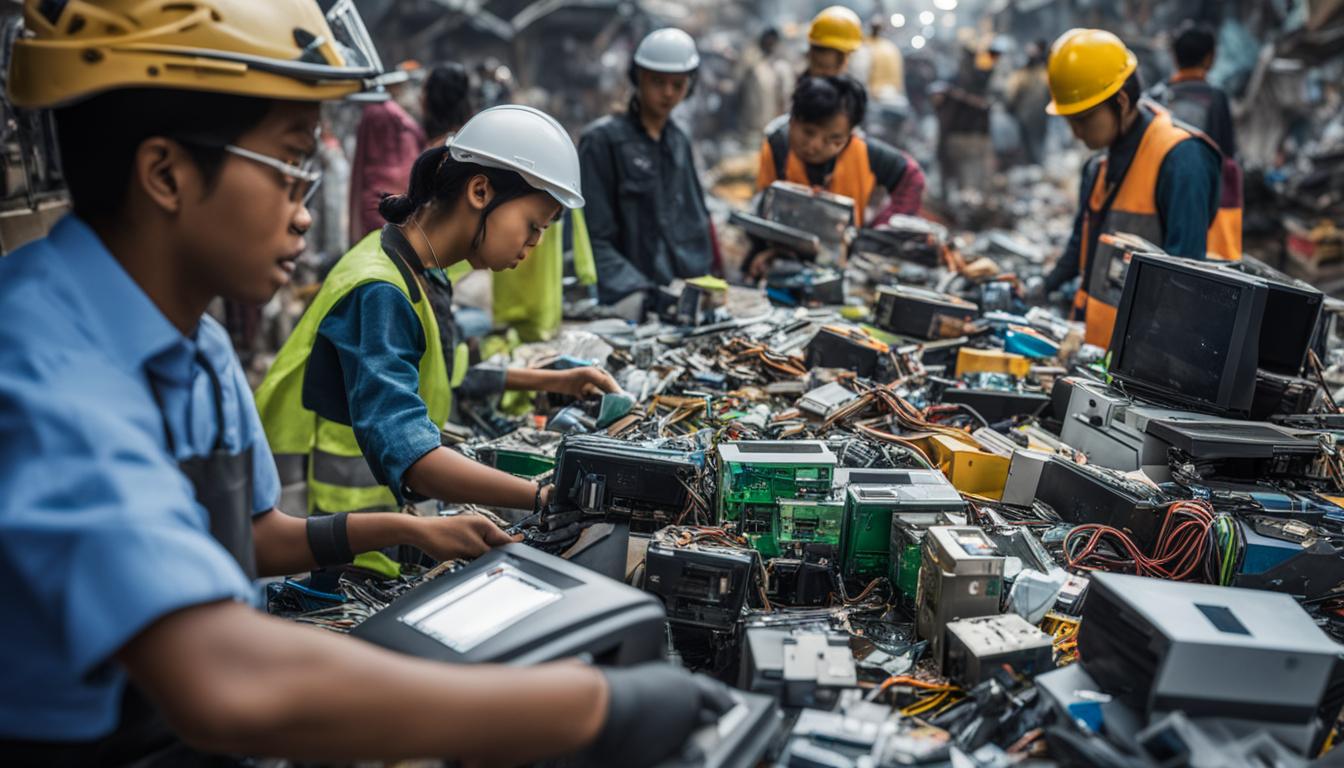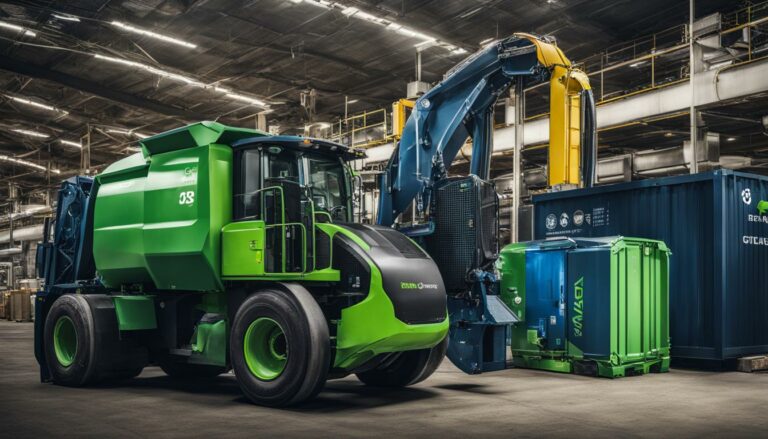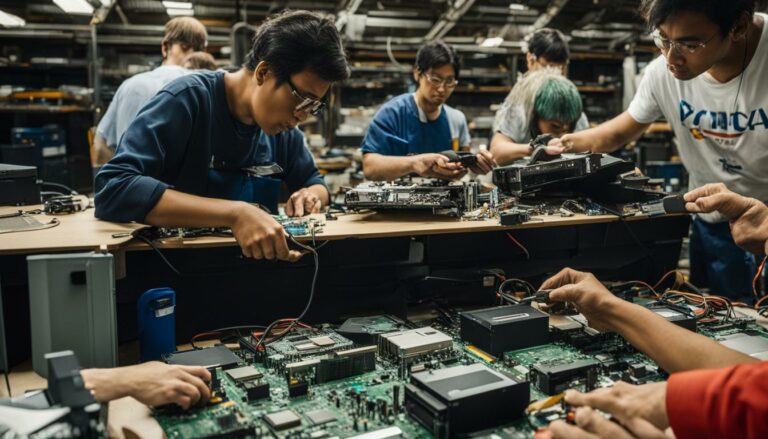Tackling the Growing Mountain of E-waste: A Global Perspective
A smartphone is used by three unique users, on average, before it becomes e-waste in India. Electronic waste, or e-waste, is the world’s fastest-growing waste stream and has a crippling effect on the environment. In 2019, a staggering 53.6 million metric tonnes of e-waste were generated worldwide. This growing mountain of e-waste poses significant challenges, but there are global efforts to tackle the issue through electronic waste recycling and the implementation of e-waste legislation.
Key Takeaways:
- The global e-waste perspective presents significant challenges and opportunities for sustainable solutions.
- Electronic waste recycling and e-waste legislation are crucial for tackling the growing mountain of e-waste.
- Businesses, governments, and individuals must prioritize responsible e-waste management.
- Sustainable electronics practices can help reduce the environmental impact of e-waste.
- Effective e-waste legislation is needed to ensure responsible and sustainable management of electronic waste.
The Environmental Impact of E-waste
E-waste, also known as electronic waste, poses a significant threat to the environment due to its toxic components. When improperly disposed of in landfills, e-waste releases hazardous materials that can contaminate soil, water, air, and harm wildlife. The exponential growth of e-waste worldwide further exacerbates these risks.
According to electronic waste statistics, the global generation of e-waste reached a staggering 53.6 million metric tonnes in 2019. This figure is projected to increase to a daunting 74 million metric tonnes by 2030. Such alarming statistics emphasize the urgent need for sustainable solutions to manage and recycle electronic waste effectively.
“The improper disposal of e-waste poses a grave threat to our environment. The hazardous materials found in electronic devices, such as lead, mercury, and cadmium, can leak into soil, water sources, and the atmosphere, causing pollution and putting ecosystems at risk.” – Environmental Scientist
To further comprehend the environmental impact of e-waste, a detailed analysis is required. The following table provides insights into the materials found in electronic waste and their potential harm when not properly managed:
| Material | Potential Harm |
|---|---|
| Lead | Neurotoxic effects, developmental issues |
| Mercury | Neurological damage, kidney failure |
| Cadmium | Kidney damage, lung cancer |
| Brominated Flame Retardants | Hormonal disruptions, developmental disorders |
As evidenced by the table, these materials can have severe health implications and long-lasting consequences for the environment. Proper e-waste management, including recycling and responsible disposal, is crucial for minimizing these environmental risks and paving the way for a greener future.
The Role of Businesses in E-waste Generation
The growing problem of e-waste is not solely the responsibility of individuals; businesses also play a significant role in its generation. This issue has been exacerbated by the COVID-19 pandemic, as companies invested heavily in new technology to facilitate remote working. However, many businesses are unaware of where their e-waste ends up, leading to improper disposal methods, including dumping old technology in landfills.
A recent study revealed that one in ten businesses admitted to engaging in such irresponsible e-waste disposal practices. This lack of awareness and accountability highlights the urgent need for businesses to take responsibility for their e-waste and implement proper e-waste management strategies.
“It is crucial for businesses to prioritize responsible e-waste management and adopt sustainable strategies to minimize their environmental impact.”
– Environment Expert
| Key Challenges in E-waste Management for Businesses | Recommended Solutions |
|---|---|
| Lack of awareness about e-waste disposal methods | Educating employees about the importance of responsible e-waste management and providing clear guidelines for proper disposal |
| Difficulty in tracking e-waste disposal process | Implementing a tracking system to monitor the entire lifecycle of IT devices, from procurement to disposal |
| Cost implications of proper e-waste management | Exploring partnerships with electronic waste recycling companies and taking advantage of government subsidies or incentives |
By embracing responsible e-waste management, businesses not only contribute to the preservation of the environment but also enhance their brand image and reputation. Consumers are increasingly demanding sustainable practices from the companies they engage with, and responsible e-waste management is a crucial aspect of meeting these expectations. Businesses that prioritize sustainable strategies and work towards reducing their e-waste footprint can gain a competitive edge in the market.
The Solution: Embracing Sustainable Electronics
In order to address the mounting e-waste problem, it is essential for individuals, businesses, and governments to shift towards embracing sustainable electronics. This means adopting a circular economy model where devices are refurbished, resold, or recycled, rather than ending up in landfills. By implementing electronic waste recycling programs and enforcing strict electronic waste legislation, organizations can ensure responsible and sustainable management of their IT devices.
Embracing sustainable electronics not only helps reduce the environmental impact of e-waste but also brings about numerous benefits for businesses. By participating in electronic waste recycling programs, organizations can minimize their contribution to the growing mountain of e-waste while also reducing carbon emissions. Furthermore, responsible e-waste management strategies can lead to cost savings and improved performance for businesses.
By taking a proactive approach to sustainable IT device management, businesses can align with the principles of the circular economy and operate more sustainably. This includes implementing responsible e-waste disposal practices, partnering with certified e-waste recyclers, and promoting device refurbishment and reuse. Through these efforts, organizations can not only reduce their environmental footprint but also contribute to the development of a more sustainable future.
| Benefits of Embracing Sustainable Electronics |
|---|
| Reduction of e-waste |
| Minimization of carbon emissions |
| Cost savings |
| Improved performance |
| Alignment with the circular economy |
The Benefits of Sustainable IT Device Management
A service-based subscription model for IT device management offers numerous benefits for organizations. By adopting this approach, businesses can shift away from the traditional “buy, use, dispose” mentality towards a more sustainable “take, make, reuse, recycle” mindset. This not only helps in minimizing e-waste but also brings a range of advantages for businesses.
Firstly, adopting a service-based subscription model can significantly reduce costs for organizations. Instead of making large upfront investments in purchasing new devices, businesses can opt to lease or rent IT equipment based on their needs. This allows for more flexibility and scalability, enabling organizations to adapt to changing technology requirements without unnecessary financial burdens.
Secondly, third-party IT device management services can help businesses boost performance and productivity. These services often include regular maintenance, software updates, and technical support, ensuring that devices are always in optimal working condition. By outsourcing these tasks to experts, organizations can streamline their IT operations and focus on core business activities.
Table: Comparison of Traditional vs. Sustainable IT Device Management
| Aspect | Traditional IT Device Management | Sustainable IT Device Management |
|---|---|---|
| Cost | High upfront investment | Reduced costs through leasing or renting |
| Performance | Limited support and maintenance | Regular maintenance, software updates, and technical support |
| E-waste | Contributes to e-waste through frequent device replacements | Minimizes e-waste through device reuse and recycling |
| Flexibility | Limited scalability and adaptability | Flexible and scalable based on changing technology needs |
Lastly, sustainable IT device management aligns with the principles of the circular economy and responsible e-waste management. By reusing and recycling IT devices, organizations significantly reduce their environmental impact. This not only helps in reducing electronic waste but also lowers carbon emissions associated with the manufacturing and disposal of new devices. It showcases a commitment to sustainability and responsible business practices.
Overall, embracing a service-based subscription model for IT device management can deliver cost savings, improved performance, and a reduced environmental footprint. By adopting responsible e-waste management strategies and prioritizing electronic waste recycling programs, organizations can contribute to a more sustainable future while meeting the demands of technological advancement.
The Importance of Balancing Sustainability and Technological Advancement
Striking the right balance between sustainability and technological advancement is crucial for businesses. While there is increasing pressure to operate more sustainably and reduce carbon emissions, there is also a need for the latest technology to support business operations. By adopting sustainable electronics practices, organizations can access the latest technology while minimizing their environmental impact. This approach aligns with the demand for businesses to take a stand on sustainability and meet the expectations of their customers and partners.
Embracing sustainable electronics involves several key strategies. Firstly, organizations can prioritize the use of energy-efficient devices that consume less power and have a longer lifespan. This not only reduces e-waste but also lowers electricity costs and contributes to a greener workspace. Additionally, businesses can implement recycling programs for their electronic devices, ensuring that old equipment is properly disposed of or refurbished for reuse.
Moreover, electronic waste legislation plays a crucial role in promoting sustainable practices. Governments around the world have a responsibility to enact and enforce regulations that promote responsible e-waste management. This includes setting standards for the disposal and recycling of electronic devices, as well as incentivizing businesses to adopt sustainable practices through tax incentives or grants. By establishing a legal framework, governments can encourage businesses to prioritize sustainability and contribute to a circular economy.
| Benefits of Balancing Sustainability and Technological Advancement | Sustainable Electronics Strategies | Electronic Waste Legislation |
|---|---|---|
| Access to latest technology | Use of energy-efficient devices | Regulations for proper disposal and recycling |
| Reduced environmental impact | Implementation of recycling programs | Incentives for sustainable practices |
| Meeting customer expectations | Refurbishing old equipment for reuse | Promoting a circular economy |
By prioritizing sustainability and incorporating it into their operations, businesses can lead the way towards a more sustainable future. The importance of balancing sustainability and technological advancement cannot be overstated. It is not a choice between one or the other; rather, it is finding innovative ways to embrace technology while minimizing its impact on the environment. By doing so, businesses can meet the needs of the present without compromising the needs of future generations.

Conclusion
The global e-waste perspective presents significant challenges but also opportunities for sustainable solutions. It is crucial for businesses, governments, and individuals to prioritize responsible e-waste management and electronic waste recycling. By embracing sustainable electronics practices and implementing effective e-waste legislation, the growing mountain of e-waste can be tackled, leading to a more sustainable future.
Electronic waste recycling plays a vital role in mitigating the environmental impact caused by the improper disposal of e-waste. Through proper recycling processes, valuable materials can be recovered and reused, reducing the need for resource extraction and minimizing pollution. Responsible e-waste management also ensures that hazardous substances present in electronic devices are handled safely, protecting both human health and the environment. It is crucial for organizations to engage in electronic waste recycling initiatives to contribute to a more sustainable and circular economy.
Furthermore, responsible e-waste management extends beyond the recycling process. It involves adopting sustainable practices throughout the entire lifecycle of electronic devices. This includes considering the design of products to be more easily repairable and upgradable, promoting extended lifecycles through refurbishment and resale, and implementing proper end-of-life disposal methods. By embracing responsible e-waste management practices, we can minimize the negative environmental and social impacts of e-waste and work towards a more sustainable future.
In conclusion, addressing the global e-waste challenge requires a collective effort from all stakeholders. Governments should enact and enforce stringent e-waste legislation, holding businesses accountable for their electronic waste disposal practices. Businesses themselves must prioritize responsible e-waste management, adopting sustainable electronics practices and implementing effective recycling programs. As individuals, we can contribute by practicing proper disposal of our electronic devices and supporting initiatives that promote electronic waste recycling. Together, we can overcome the e-waste crisis and create a more sustainable and environmentally conscious world.
FAQ
What is e-waste?
E-waste refers to electronic waste, which includes discarded electronic devices such as smartphones, computers, and televisions.
How much e-waste is generated worldwide?
In 2019, a staggering 53.6 million metric tonnes of e-waste were generated globally.
What are the environmental risks associated with e-waste?
E-waste contains toxic materials that can pose serious risks to the environment, including soil, water, air, and wildlife, when improperly disposed of in landfills.
What is the predicted amount of e-waste by 2030?
By 2030, it is estimated that the global amount of e-waste will reach a staggering 74 million metric tonnes.
How do businesses contribute to the e-waste problem?
Many businesses invest heavily in new technology, resulting in a significant amount of e-waste. Some businesses also admit to dumping old technology in landfills.
What can businesses do to manage their e-waste responsibly?
Businesses can take responsibility for their e-waste by implementing responsible e-waste management strategies, such as electronic waste recycling and enforcing strict electronic waste legislation.
What is the circular economy model?
The circular economy model is an approach that promotes the refurbishment, resale, or recycling of devices, aiming to reduce e-waste and carbon emissions.
What benefits can businesses gain from adopting a service-based subscription model for IT device management?
By adopting a service-based subscription model, businesses can reduce costs, boost performance, and minimize e-waste by utilizing third-party services to manage and refresh IT devices.
How can businesses strike a balance between sustainability and technological advancement?
Businesses can adopt sustainable electronics practices, ensuring access to the latest technology while minimizing their environmental impact. This aligns with the demand for businesses to prioritize sustainability.
What can individuals do to contribute to responsible e-waste management?
Individuals can prioritize electronic waste recycling and be aware of where their e-waste ends up. They can also advocate for responsible e-waste management and support businesses that take sustainability seriously.












